
|
Now it is 6.1 mag (Nov. 24, Alan Hale). It was expected to brighten up to 4-5 mag from autumn to winter. However, the brightness evolution has stopped in September. In the Northern Hemisphere, it is appearing in the morning sky. It will be observable in excellent condition after this. In the Southern Hemisphere, it is hardly observable after this.
Date(TT) R.A. (2000) Decl. Delta r Elong. m1 Best Time(A, h)
Nov. 28 14 19.47 -13 7.6 1.585 0.855 28 6.0 2:57 (289, -4)
Dec. 5 14 18.54 -9 5.4 1.461 0.899 37 5.9 2:54 (282, -1)
|
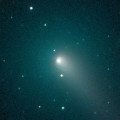
|
It brightened very rapidly. Now it is so bright as 8.8 mag (Nov. 20, Seiichi Yoshida). It is observable at 9-10 mag until next spring in excellent condition in the Northern Hemisphere. It keeps unobservable in the Southern Hemisphere.
Date(TT) R.A. (2000) Decl. Delta r Elong. m1 Best Time(A, h)
Nov. 28 16 39.63 66 5.3 1.905 2.105 87 9.3 20:38 (152,-46)
Dec. 5 16 44.31 64 28.6 1.913 2.101 86 9.3 2:54 (209,-50)
|
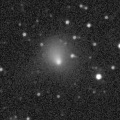
|
Now it is so bright as 10.1 mag (Nov. 18, Katsumi Yoshimoto). It will pass close to the earth from spring to summer in 2016, and it is expected to be observable at 6-7 mag in good condition. It is observable in excellent condition in the Northern Hemispehre. It locates very low in the Southern Hemisphere.
Date(TT) R.A. (2000) Decl. Delta r Elong. m1 Best Time(A, h)
Nov. 28 1 57.76 40 26.2 1.535 2.413 145 10.3 21:27 (180, 15)
Dec. 5 1 24.22 36 44.8 1.537 2.339 134 10.1 20:46 (176, 18)
|

|
It tends to brighten very rapidly around the perihelion passage. It will appear in the evening sky in early December, then it will fade out very rapidly.
Date(TT) R.A. (2000) Decl. Delta r Elong. m1 Best Time(A, h)
Nov. 28 17 41.08 -20 17.6 1.284 0.500 20 11.2 20:38 ( 62, -4)
Dec. 5 18 36.40 -19 24.7 1.178 0.531 26 11.5 20:46 ( 66, -1)
|

|
Now it is bright as 9.7 mag (Nov. 30, Juan Jose Gonzalez). It is observable in the evening low sky until early December in the Southern Hemisphere, or until late December in the Northern Hemisphere.
Date(TT) R.A. (2000) Decl. Delta r Elong. m1 Best Time(A, h)
Nov. 28 18 55.21 -23 3.7 2.262 1.596 37 11.3 20:38 ( 70, 11)
Dec. 5 19 18.36 -22 41.2 2.306 1.612 35 11.5 20:46 ( 68, 9)
|
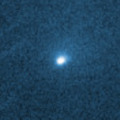
|
It brightened very rapidly. Now it is bright as 9.2 mag (Nov. 30, Juan Jose Gonzalez). It keeps 11-13 mag until February. But it keeps very low.
Date(TT) R.A. (2000) Decl. Delta r Elong. m1 Best Time(A, h)
Nov. 28 19 38.71 -25 24.6 1.899 1.425 47 11.4 20:38 ( 73, 21)
Dec. 5 20 4.47 -24 57.2 1.933 1.434 45 11.5 20:46 ( 72, 19)
|
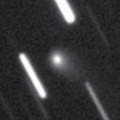
|
Now it is bright as 12.4 mag (Nov. 20, Seiichi Yoshida). It keeps 12 mag for a long time from 2015 autumn to 2016 summer. In the Northern Hemispehre, it keeps observable in good condition for a long time. It keeps unobservable in the Southern Hemisphere.
Date(TT) R.A. (2000) Decl. Delta r Elong. m1 Best Time(A, h)
Nov. 28 15 22.84 85 7.1 2.442 2.881 106 12.4 2:57 (185,-37)
Dec. 5 17 18.07 82 56.3 2.432 2.855 105 12.3 20:46 (172,-39)
|

|
First return of a periodic comet which brightened up to 8 mag in major outburst in 2010. It will be observable in excellent condition from winter to spring. Now it is not detected, fainter than 20 mag (Oct. 2, Jean-Francois Soulier).
Date(TT) R.A. (2000) Decl. Delta r Elong. m1 Best Time(A, h)
Nov. 28 9 39.14 28 15.7 1.229 1.787 106 13.0 2:57 (212, 19)
Dec. 5 9 52.56 27 46.6 1.146 1.758 110 12.5 2:54 (210, 21)
|

|
It brightened up to 3.7 mag and became a naked eye comet in mid January in 2015 (Jan. 13, Marek Biely). Now it is fading. But it is bright as 10.7 mag still now (Nov. 7, Neil Norman). In the Northern Hemisphere, it keeps observable for a long time until the comet fades out, although it becomes low temporarily in December. It is not observable until March in the Southern Hemisphere.
Date(TT) R.A. (2000) Decl. Delta r Elong. m1 Best Time(A, h)
Nov. 28 17 18.10 22 24.6 4.663 4.046 46 12.7 20:38 ( 95,-34)
Dec. 5 17 25.17 21 42.7 4.750 4.115 45 12.9 20:46 ( 90,-40)
|

|
Now it is 12.5 mag (Nov. 20, Seiichi Yoshida). It will be fading slowly after this. In the Northern Hemisphere, it keeps observable in good condition. It will be getting higher gradually after this also in the Southern Hemisphere.
Date(TT) R.A. (2000) Decl. Delta r Elong. m1 Best Time(A, h)
Nov. 28 11 39.69 9 53.0 1.757 1.760 73 13.1 2:57 (247, 15)
Dec. 5 11 50.11 9 5.6 1.735 1.813 78 13.3 2:54 (245, 18)
|

|
It brightened up to 13 mag in outburst on Nov. 13 (Rob Kaufman). It will be unobservable soon.
Date(TT) R.A. (2000) Decl. Delta r Elong. m1 Best Time(A, h)
Nov. 28 18 7.89 -28 19.2 6.849 5.986 26 14.0 20:38 ( 59, 5)
Dec. 5 18 13.97 -28 12.5 6.891 5.984 21 14.0 20:46 ( 55, 0)
|

|
Now it is 14.9 mag (Nov. 13, Hidetaka Sato). It will brighten up to 13 mag from winter to spring. It will be observable in excellent condition in the Southern Hemisphere. But it locates somewhat low in the Northern Hemisphere.
Date(TT) R.A. (2000) Decl. Delta r Elong. m1 Best Time(A, h)
Nov. 28 13 7.21 -5 56.8 2.754 2.210 47 14.3 2:57 (273, 7)
Dec. 5 13 20.41 -7 23.0 2.687 2.203 50 14.2 2:54 (272, 10)
|
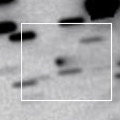
|
Now it is 15.8 mag (Nov. 20, K. Hills). It will brighten up to 11 mag from spring to summer. In the Northern Hemisphere, it keeps observable in good condition while the comet will be brightening. It locates somewhat low in the Southern Hemisphere.
Date(TT) R.A. (2000) Decl. Delta r Elong. m1 Best Time(A, h)
Nov. 28 5 56.77 19 17.9 1.703 2.633 155 14.7 1:32 (180, 36)
Dec. 5 5 51.18 19 15.1 1.631 2.592 163 14.4 0:59 (180, 36)
|

|
Now it is 14.8 mag (Nov. 22, Catalina Sky Survey). Distant object, but it keeps observable at 14-15 mag for a long time from 2015 to 2016.
Date(TT) R.A. (2000) Decl. Delta r Elong. m1 Best Time(A, h)
Nov. 28 21 28.58 -7 52.2 5.189 5.056 76 14.6 20:38 (105, 34)
Dec. 5 21 33.27 -7 52.2 5.280 5.043 70 14.6 20:46 (100, 27)
|

|
It brightened up to 8.8 mag in 2015 spring (Apr. 3, Marco Goiato). Now it is fading. It has already faded down to 13.5 mag (Nov. 11, Mike Wolle). It keeps observable until March when the comet becomes fainter than 18 mag.
Date(TT) R.A. (2000) Decl. Delta r Elong. m1 Best Time(A, h)
Nov. 28 1 49.77 9 30.2 1.744 2.606 143 14.7 21:22 (180, 45)
Dec. 5 1 47.35 9 31.0 1.850 2.649 136 15.0 20:52 (180, 45)
|
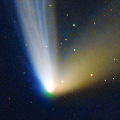
|
It approached to the sun down to 0.3 a.u. on July 6, and brighted up to 3.9 mag (July 6, Thomas Lehmann). Now it is fading. It has already faded down to 12.9 mag (Oct. 3, Chris Wyatt). In the Northern Hemisphere, it keeps observable until the comet fades out. It will not be observable after this in the Northern Hemisphere.
Date(TT) R.A. (2000) Decl. Delta r Elong. m1 Best Time(A, h)
Nov. 28 16 55.73 -54 45.5 3.504 2.748 34 14.9 20:38 ( 30, 13)
Dec. 5 17 13.43 -55 13.8 3.614 2.844 33 15.1 20:46 ( 28, 11)
|
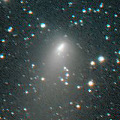
|
It brightened rapidly up to 10.4 mag from July to August (July 18, Maik Meyer). Now it is fading. It has already faded down to 14.2 mag (Nov. 11, Sandor Szabo). It is observable in good condition in the Northern Hemisphere. It is not observable in the Southern Hemisphere.
Date(TT) R.A. (2000) Decl. Delta r Elong. m1 Best Time(A, h)
Nov. 28 20 56.80 46 41.2 1.879 2.169 93 14.9 20:38 (142, -9)
Dec. 5 21 16.40 46 45.7 1.955 2.226 92 15.2 20:46 (140,-11)
|
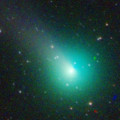
|
It brightened up to 6.0 mag in mid May (May 14, Chris Wyatt). Now it is fading. It has already faded down to 15.6 mag (Nov. 12, Sandor Szabo). In the Northern Hemisphere, it keeps observable in good condition after this while the comet will be fading. It locates somewhat low in the Southern Hemisphere.
Date(TT) R.A. (2000) Decl. Delta r Elong. m1 Best Time(A, h)
Nov. 28 7 31.98 33 39.6 2.250 3.025 134 15.1 2:57 (182, 21)
Dec. 5 7 13.97 35 11.9 2.252 3.109 144 15.2 2:22 (180, 20)
|

|
Now it is 13.6 mag (Nov. 12, Sandor Szabo). In the Northern Hemisphere, it keeps observable after this while the comet will be fading. It is not observable in the Southern Hemisphere until January when the comet will fade down to 16 mag.
Date(TT) R.A. (2000) Decl. Delta r Elong. m1 Best Time(A, h)
Nov. 28 13 15.22 20 40.1 2.674 2.347 60 15.1 2:57 (252,-10)
Dec. 5 13 26.11 20 23.4 2.655 2.398 64 15.2 2:54 (250, -7)
|
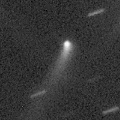
|
Now it is 15.4 mag (Nov. 15, Yuji Ohshima). It will be fading slowly after this. In the Northern Hemisphere, it keeps observable for a long time until the comet fades out. In the Southern Hemisphere, it will be unobservable in early January.
Date(TT) R.A. (2000) Decl. Delta r Elong. m1 Best Time(A, h)
Nov. 28 0 34.01 14 58.8 3.561 4.238 127 15.4 20:38 (170, 39)
Dec. 5 0 26.11 14 59.3 3.681 4.248 119 15.5 20:46 (157, 37)
|
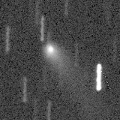
|
Now it is 15.1 mag (Nov. 11, Sandor Szabo). It keeps 15 mag for a long time from 2014 to 2015. It is observable in excellent condition in the Northern Hemisphere. It locates low in the Southern Hemisphere.
Date(TT) R.A. (2000) Decl. Delta r Elong. m1 Best Time(A, h)
Nov. 28 0 41.39 46 49.4 3.778 4.481 130 15.4 20:38 (176, 8)
Dec. 5 0 36.59 46 36.1 3.870 4.511 125 15.5 20:46 (169, 7)
|
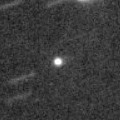
|
Now it is 15.9 mag (Nov. 12, Sandor Szabo). It is expected to brighten rapidly, and to be observable at 14.5 mag in good condition in autumn.
Date(TT) R.A. (2000) Decl. Delta r Elong. m1 Best Time(A, h)
Nov. 28 5 13.30 -5 33.6 0.552 1.489 149 15.4 0:49 (180, 61)
Dec. 5 5 11.68 -3 15.3 0.548 1.496 153 15.4 0:20 (180, 58)
|

|
Now it is 15.7 mag (Nov. 11, Sandor Szabo). It keeps 15-16 mag for a long time until 2016. It keeps observable in excellent condition in the Northern Hemisphere. It keeps unobservable in the Southern Hemisphere.
Date(TT) R.A. (2000) Decl. Delta r Elong. m1 Best Time(A, h)
Nov. 28 4 42.65 73 13.8 4.537 5.200 127 15.4 0:20 (180,-18)
Dec. 5 4 25.52 73 58.8 4.536 5.204 128 15.4 23:29 (180,-19)
|

|
First return of a periodic comet discovered in 2003. Now it is 15.5 mag (Nov. 15, Yuji Ohshima). It is brightening very rapidly. It will approach to the earth from autumn to winter, and it will brighten up to 15 mag and observable in excellent condition.
Date(TT) R.A. (2000) Decl. Delta r Elong. m1 Best Time(A, h)
Nov. 28 4 53.02 3 20.2 0.701 1.662 159 15.7 0:29 (180, 52)
Dec. 5 4 48.58 6 33.1 0.689 1.660 164 15.6 23:52 (180, 48)
|

|
First return of a periodic comet discovered in 1994. It brightened up to 13.8 mag from summer to autumn (Sept. 7, Taras Prystavski). Now it is fading, but it is bright as 15.2 mag still now (Nov. 11, Sandor Szabo). It is observable in excellent condition in the Southern Hemisphere. It locates somewhat low in the Northern Hemisphere.
Date(TT) R.A. (2000) Decl. Delta r Elong. m1 Best Time(A, h)
Nov. 28 22 58.04 -18 48.2 2.210 2.470 93 15.6 20:38 (112, 57)
Dec. 5 23 5.32 -16 55.9 2.300 2.479 88 15.7 20:46 (108, 51)
|
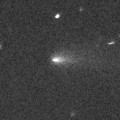
|
Now it is 14.5 mag (Nov. 11, Sandor Szabo). It keeps observable at 15 mag in good condition for a while.
Date(TT) R.A. (2000) Decl. Delta r Elong. m1 Best Time(A, h)
Nov. 28 2 10.03 3 25.7 1.273 2.159 145 15.7 21:42 (180, 51)
Dec. 5 2 9.68 3 34.7 1.332 2.170 138 15.8 21:14 (180, 51)
|
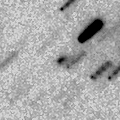
|
Brightening very rapidly, and it keeps brightening even after the perihelion passage. Now it is very bright as 15.5 mag (Nov. 21, Catalina Sky Survey). It keeps observable in excellent condition for a while.
Date(TT) R.A. (2000) Decl. Delta r Elong. m1 Best Time(A, h)
Nov. 28 6 19.27 -12 13.5 1.065 1.892 134 16.3 1:54 (180, 67)
Dec. 5 6 15.38 -13 49.9 1.071 1.916 137 16.3 1:23 (180, 69)
|

|
It brightened up to 11-12 mag in 2012. It has already faded down to 16.5 mag (July 9, Taras Prystavski). It is observable at 16 mag in good condition from winter to spring.
Date(TT) R.A. (2000) Decl. Delta r Elong. m1 Best Time(A, h)
Nov. 28 11 17.43 -6 58.5 10.782 10.527 72 16.3 2:57 (257, 29)
Dec. 5 11 16.98 -7 5.5 10.699 10.565 79 16.3 2:54 (253, 34)
|

|
It brightened up to 13 mag in 2014. It is bright as 14.8 mag visually still now (Nov. 11, Sandor Szabo). It will be fading after this, and will be fainter than 18 mag in spring.
Date(TT) R.A. (2000) Decl. Delta r Elong. m1 Best Time(A, h)
Nov. 28 0 55.69 -0 35.0 3.372 4.045 127 16.6 20:38 (176, 55)
Dec. 5 0 54.81 -0 22.3 3.477 4.060 120 16.7 20:46 (160, 54)
|

|
Now it is 16.7 mag (Nov. 5, Masayuki Suzuki). It was reported as 15.8 mag visually (Nov. 12, Sandor Szabo). It is expected to brighten up to 7 mag in 2017 summer. In the Northern Hemisphere, it keeps observable in good condition until the highlight while the comet will be brightening. In the Southern Hemisphere, it is not observable until early 2017.
Date(TT) R.A. (2000) Decl. Delta r Elong. m1 Best Time(A, h)
Nov. 28 8 17.57 58 33.5 5.685 6.276 122 16.8 2:57 (187, -4)
Dec. 5 8 15.02 59 26.8 5.567 6.217 127 16.7 2:54 (184, -5)
|
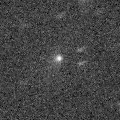
|
Now it is 16.0 mag (Nov. 12, Sandor Szabo). It is observable at 16-17 mag in good condition from October to December in the Northern Hemisphere. It is not observable in the Southern Hemisphere.
Date(TT) R.A. (2000) Decl. Delta r Elong. m1 Best Time(A, h)
Nov. 28 1 11.40 60 45.1 1.477 2.238 129 16.7 20:44 (180, -5)
Dec. 5 1 11.18 54 8.4 1.519 2.275 129 16.8 20:46 (176, 1)
|

|
Now it is 16.9 mag (Nov. 15, J. Bel). It will brighten up to 14 mag in 2016 summer. But it is not observable at the highlight. It keeps observable until March while the comet will be brightening gradually up to 15-16 mag.
Date(TT) R.A. (2000) Decl. Delta r Elong. m1 Best Time(A, h)
Nov. 28 0 15.35 -7 37.1 1.919 2.501 114 16.8 20:38 (154, 60)
Dec. 5 0 17.29 -7 16.6 1.975 2.472 108 16.8 20:46 (140, 56)
|
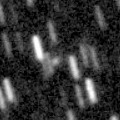
|
Now it is 17.0 mag (Nov. 3, A. Maury, J.-F. Soulier, J.-G. Bosch, T. Noel). It keeps 16.5 mag for a long time in 2016, and it will be observable in excellent condition in the Southern Hemisphere. It is hardly observable in the Northern Hemisphere.
Date(TT) R.A. (2000) Decl. Delta r Elong. m1 Best Time(A, h)
Nov. 28 8 31.98 -54 34.4 3.614 3.686 86 17.0 2:57 (334, 67)
Dec. 5 8 17.96 -57 4.8 3.545 3.660 88 16.9 2:54 (349, 67)
|

|
Now it is 17.5 mag (Nov. 13, Hidetaka Sato). It will brighten rapidly after this, and it will be observable at 14-15 mag in good condition from winter to summer.
Date(TT) R.A. (2000) Decl. Delta r Elong. m1 Best Time(A, h)
Nov. 28 12 32.88 9 14.6 2.891 2.580 62 17.0 2:57 (255, 5)
Dec. 5 12 42.16 7 56.5 2.794 2.562 66 16.9 2:54 (254, 8)
|

|
It brightened up to 6.9 mag in 2014 autumn (Oct. 17, Marco Goiato). Now it is fading. It has already faded down to 17.2 mag (Nov. 16, K. Hills). In the Southern Hemisphere, it keeps observable in good condition until the comet fades out. In the Northern Hemisphere, it keeps observable until winter, but it locates somewhat low.
Date(TT) R.A. (2000) Decl. Delta r Elong. m1 Best Time(A, h)
Nov. 28 22 35.05 -26 54.3 5.662 5.665 85 17.1 20:38 ( 94, 57)
Dec. 5 22 34.40 -26 24.2 5.845 5.729 78 17.2 20:46 ( 89, 49)
|
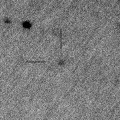
|
Now it is 17.2 mag (Nov. 18, Catalina Sky Survey). Now it is near the aphelion. It is observable at 17 mag in good condition from autumn to winter.
Date(TT) R.A. (2000) Decl. Delta r Elong. m1 Best Time(A, h)
Nov. 28 3 24.67 15 23.9 3.300 4.268 167 17.2 22:56 (180, 40)
Dec. 5 3 20.32 15 15.8 3.324 4.260 159 17.2 22:24 (180, 40)
|
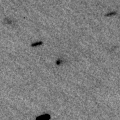
|
Now it is 16.9 mag (Nov. 17, J. Nicolas, C. Rinner, F. Kugel, A. Klotz). It will brighten up to 14 mag in 2017. In 2016, it keeps observable at 16 mag in good condition from winter to spring.
Date(TT) R.A. (2000) Decl. Delta r Elong. m1 Best Time(A, h)
Nov. 28 11 46.80 11 1.5 4.273 4.092 72 17.3 2:57 (247, 13)
Dec. 5 11 51.56 10 44.4 4.155 4.077 78 17.2 2:54 (244, 16)
|
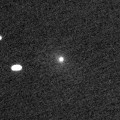
|
Now it is 16.9 mag (Nov. 14, J. Bel). It keeps observable in good condition until the comet fades out. In 2014, it must have been observable at 14 mag in good condition in the Southern Hemisphere.
Date(TT) R.A. (2000) Decl. Delta r Elong. m1 Best Time(A, h)
Nov. 28 23 55.50 3 35.1 4.298 4.801 115 17.3 20:38 (153, 48)
Dec. 5 23 55.74 3 53.9 4.454 4.853 108 17.4 20:46 (142, 44)
|
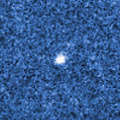
|
Now it is 17.1 mag (Nov. 17, K. Hills). It will brighten up to 16 mag in 2016 summer. In the Southern Hemisphere, it keeps observable in good condition for a long time. In the Northern Hemisphere, it is observable only until next March.
Date(TT) R.A. (2000) Decl. Delta r Elong. m1 Best Time(A, h)
Nov. 28 5 16.19 -13 18.6 2.348 3.186 142 17.4 0:52 (180, 68)
Dec. 5 5 5.58 -15 57.9 2.306 3.137 141 17.3 0:14 (180, 71)
|

|
Now it is 17.3 mag (Nov. 21, Catalina Sky Survey). It is observable at 16.5 mag in excellent condition from December to February. It locates somewhat low in the Southern Hemisphere.
Date(TT) R.A. (2000) Decl. Delta r Elong. m1 Best Time(A, h)
Nov. 28 8 23.64 17 19.4 1.229 1.933 121 17.5 2:57 (198, 36)
Dec. 5 8 29.27 17 29.8 1.170 1.930 126 17.3 2:54 (193, 37)
|
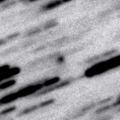
|
Now it is 16.8 mag (Nov. 20, Catalina Sky Survey). It keeps observable in good condition for a while. But it will be fainter than 18 mag in January.
Date(TT) R.A. (2000) Decl. Delta r Elong. m1 Best Time(A, h)
Nov. 28 3 52.87 26 40.2 1.796 2.777 172 17.3 23:24 (180, 28)
Dec. 5 3 46.97 26 6.8 1.838 2.806 166 17.4 22:51 (180, 29)
|

|
Now it is 17.4 mag (Nov. 21, Space Surveillance Telescope, Atom Site). It is observable at 17 mag in good condition in winter.
Date(TT) R.A. (2000) Decl. Delta r Elong. m1 Best Time(A, h)
Nov. 28 8 20.84 12 54.3 1.725 2.383 120 17.5 2:57 (199, 40)
Dec. 5 8 23.19 13 29.4 1.647 2.376 127 17.3 2:54 (192, 41)
|
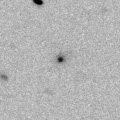
|
Now it is 17.5 mag (Oct. 28, Yasukazu Ikari). It will be fading after this. It will be fainter than 18 mag at the end of 2015.
Date(TT) R.A. (2000) Decl. Delta r Elong. m1 Best Time(A, h)
Nov. 28 23 42.96 -6 53.6 2.021 2.509 108 17.4 20:38 (141, 56)
Dec. 5 23 48.97 -6 11.0 2.113 2.519 102 17.5 20:46 (132, 51)
|
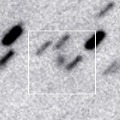
|
Now it is 17.2 mag (Nov. 7, K. Sarneczky). It keeps 17.5 mag for a long time from 2016 to 2019. It keeps locating near by the equator.
Date(TT) R.A. (2000) Decl. Delta r Elong. m1 Best Time(A, h)
Nov. 28 8 16.05 -0 53.8 9.735 10.217 116 17.5 2:57 (203, 54)
Dec. 5 8 15.56 -0 57.6 9.629 10.203 123 17.5 2:54 (193, 55)
|
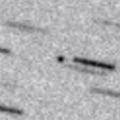
|
Now it is 17.1 mag (Nov. 17, K. Hills). It is observable in good condition in the Northern Hemisphere. It is not observable in the Southern Hemisphere.
Date(TT) R.A. (2000) Decl. Delta r Elong. m1 Best Time(A, h)
Nov. 28 11 13.51 42 19.6 1.628 1.957 93 17.5 2:57 (219, -4)
Dec. 5 11 22.43 43 8.5 1.613 2.008 98 17.5 2:54 (216, -2)
|
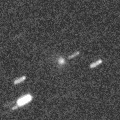
|
Now it is 17.5 mag (Nov. 18, M. Jaeger, W. Vollmann, E. Prosperi, S. Prosperi). It was expected to be observable at 16 mag in good condition from summer to winter. But actually, it is fainter than originally predicted, and it will be 17.5 mag at best.
Date(TT) R.A. (2000) Decl. Delta r Elong. m1 Best Time(A, h)
Nov. 28 22 45.01 -0 30.4 1.648 2.025 97 17.6 20:38 (129, 42)
Dec. 5 22 52.00 1 3.1 1.706 2.006 92 17.7 20:46 (123, 36)
|

|
It will pass the perihelion in 2019. However, it has not been brightening since the discovery in 2010. Now it is 17.6 mag (Nov. 13, E. Bryssinck). It keeps observable in excellent condition from autumn to next spring in the Northern Hemisphere. It is not observable in the Southern Hemisphere.
Date(TT) R.A. (2000) Decl. Delta r Elong. m1 Best Time(A, h)
Nov. 28 3 27.36 47 51.3 9.999 10.878 151 17.7 22:59 (180, 7)
Dec. 5 3 24.04 47 51.9 9.990 10.854 149 17.7 22:28 (180, 7)
|
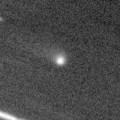
|
It brightened up to 16 mag in early 2015. Now it is fading. It is observable at 18 mag from winter to spring.
Date(TT) R.A. (2000) Decl. Delta r Elong. m1 Best Time(A, h)
Nov. 28 10 46.89 -22 6.0 6.011 5.830 74 17.8 2:57 (268, 44)
Dec. 5 10 44.04 -22 40.4 5.916 5.851 81 17.7 2:54 (265, 50)
|

|
Now it is 16.5 mag (Sept. 8, Jean-Francois Soulier). It has brightened in outburst up to 14 mag twice, in 2006 January and 2011 May. It is around the perihelion now. It keeps observable at 17 mag for a long time after this.
Date(TT) R.A. (2000) Decl. Delta r Elong. m1 Best Time(A, h)
Nov. 28 23 5.67 -5 55.6 5.660 5.911 100 17.7 20:38 (130, 50)
Dec. 5 23 7.45 -5 47.3 5.777 5.917 93 17.8 20:46 (121, 44)
|
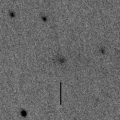
|
Now it is 17.7 mag (Nov. 30, Hidetaka Sato). It was expected to brighten up to 14 mag from winter to summer. But it is much fainter actually. It will be observable in excellent condition in the Southern Hemisphere. It locates low in the Northern Hemisphere.
Date(TT) R.A. (2000) Decl. Delta r Elong. m1 Best Time(A, h)
Nov. 28 13 17.78 -4 12.3 2.894 2.316 45 17.8 2:57 (273, 3)
Dec. 5 13 31.18 -6 3.8 2.820 2.297 49 17.8 2:54 (273, 7)
|
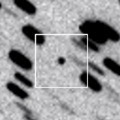
|
Now it is 17.4 mag (Nov. 8, Jean-Francois Soulier). Now it is around the aphelion. It is observable at 17.5 mag in excellent condition in autumn in the Northern Hemisphere. It locates low in the Southern Hemisphere.
Date(TT) R.A. (2000) Decl. Delta r Elong. m1 Best Time(A, h)
Nov. 28 1 49.46 34 33.0 1.521 2.402 145 17.9 21:21 (180, 21)
Dec. 5 1 38.65 32 25.6 1.577 2.402 138 18.1 20:46 (179, 23)
|

|
Now it is 17.8 mag (Nov. 18, M. Adamovsky). It will brighten up to 13 mag in 2016 summer. But it is not observable around the highlight. In the Southern Hemisphere, it is observable until February when it brightens up to 17 mag. In the Northern Hemisphere, it is observable until April when it brightens up to 16 mag.
Date(TT) R.A. (2000) Decl. Delta r Elong. m1 Best Time(A, h)
Nov. 28 2 4.64 13 20.6 2.854 3.730 148 18.0 21:36 (180, 42)
Dec. 5 2 0.60 12 44.6 2.849 3.661 140 17.9 21:05 (180, 42)
|
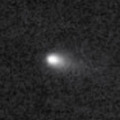
|
It brightened up to 15.9 mag in June as predicted (June 23, Ken-ichi Kadota). It was expected to be observable at 13 mag in good condition from summer to autumn. However, Jean-Gabriel Bosch detected the comet became disintegrating in July. Now it is so faint as 20.1 mag (Oct. 15, Pan-STARRS 1, Haleakala). The fragment D and B are also observed as 18.6 mag (Oct. 31, Catalina Sky Survey) and 20.9 mag (Aug. 21, Pan-STARRS 1, Haleakala) respectively.
Date(TT) R.A. (2000) Decl. Delta r Elong. m1 Best Time(A, h)
Nov. 28 1 58.10 5 42.8 1.096 1.980 143 20.2 21:30 (180, 49)
Dec. 5 1 58.83 6 30.1 1.174 2.013 137 20.4 21:03 (180, 48)
|
|
![]()
 22P/Kopff
22P/Kopff 10P/Tempel 2
10P/Tempel 2 C/2014 W2 ( PanSTARRS )
C/2014 W2 ( PanSTARRS ) P/2010 V1 ( Ikeya-Murakami )
P/2010 V1 ( Ikeya-Murakami ) C/2014 Q2 ( Lovejoy )
C/2014 Q2 ( Lovejoy ) 67P/Churyumov-Gerasimenko
67P/Churyumov-Gerasimenko 29P/Schwassmann-Wachmann 1
29P/Schwassmann-Wachmann 1 116P/Wild 4
116P/Wild 4 81P/Wild 2
81P/Wild 2 C/2011 KP36 ( Spacewatch )
C/2011 KP36 ( Spacewatch ) 88P/Howell
88P/Howell C/2014 Q1 ( PanSTARRS )
C/2014 Q1 ( PanSTARRS ) C/2015 F4 ( Jacques )
C/2015 F4 ( Jacques ) C/2015 G2 ( MASTER )
C/2015 G2 ( MASTER ) 19P/Borrelly
19P/Borrelly C/2014 A4 ( SONEAR )
C/2014 A4 ( SONEAR ) C/2014 N3 ( NEOWISE )
C/2014 N3 ( NEOWISE ) 230P/LINEAR
230P/LINEAR C/2013 V4 ( Catalina )
C/2013 V4 ( Catalina ) 329P/2015 T1 ( LINEAR-Catalina )
329P/2015 T1 ( LINEAR-Catalina ) 318P/2014 M6 ( McNaught-Hartley )
318P/2014 M6 ( McNaught-Hartley ) 61P/Shajn-Schaldach
61P/Shajn-Schaldach P/2015 Q1 ( Scotti )
P/2015 Q1 ( Scotti ) C/2006 S3 ( LONEOS )
C/2006 S3 ( LONEOS ) 117P/Helin-Roman-Alu 1
117P/Helin-Roman-Alu 1 C/2015 V2 ( Johnson )
C/2015 V2 ( Johnson ) C/2015 GX ( PanSTARRS )
C/2015 GX ( PanSTARRS ) 118P/Shoemaker-Levy 4
118P/Shoemaker-Levy 4 C/2015 B2 ( PanSTARRS )
C/2015 B2 ( PanSTARRS ) 77P/Longmore
77P/Longmore C/2012 K1 ( PanSTARRS )
C/2012 K1 ( PanSTARRS ) 74P/Smirnova-Chernykh
74P/Smirnova-Chernykh 65P/Gunn
65P/Gunn C/2015 K1 ( MASTER )
C/2015 K1 ( MASTER ) C/2015 T4 ( PanSTARRS )
C/2015 T4 ( PanSTARRS ) 204P/LINEAR-NEAT
204P/LINEAR-NEAT 44P/Reinmuth 2
44P/Reinmuth 2 211P/Hill
211P/Hill 151P/Helin
151P/Helin C/2014 B1 ( Schwartz )
C/2014 B1 ( Schwartz ) 162P/Siding Spring
162P/Siding Spring 50P/Arend
50P/Arend C/2010 U3 ( Boattini )
C/2010 U3 ( Boattini ) C/2013 G9 ( Tenagra )
C/2013 G9 ( Tenagra ) 174P/(60558) 2000 EC98 ( Echeclus )
174P/(60558) 2000 EC98 ( Echeclus ) C/2014 Y1 ( PanSTARRS )
C/2014 Y1 ( PanSTARRS ) (3200) Phaethon
(3200) Phaethon C/2015 TQ209 ( LINEAR )
C/2015 TQ209 ( LINEAR ) 51P/Harrington
51P/Harrington![]()












































